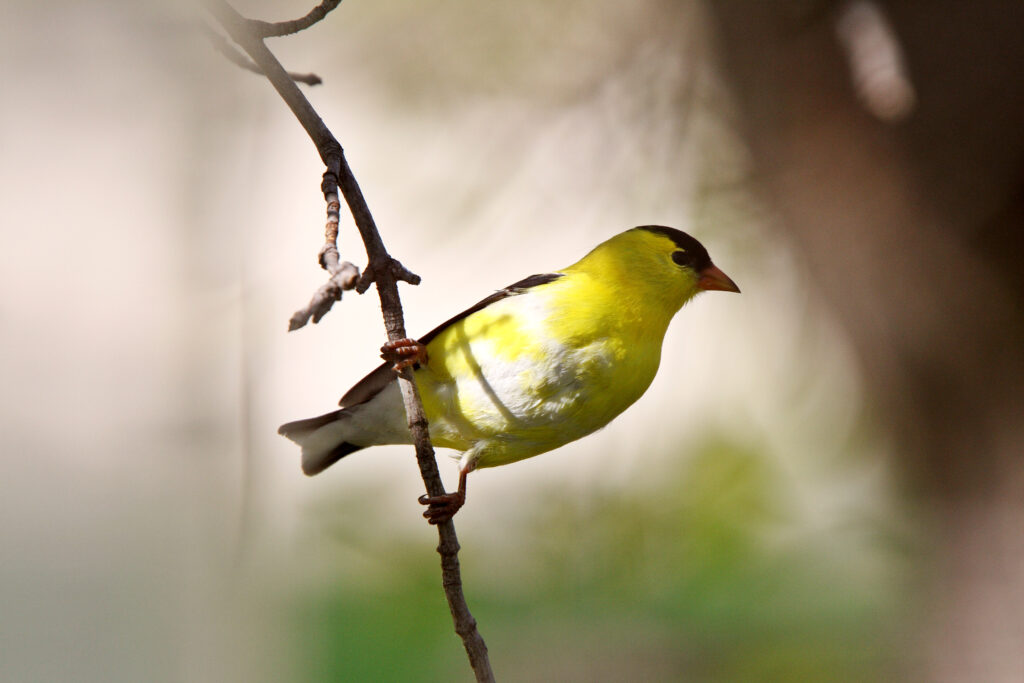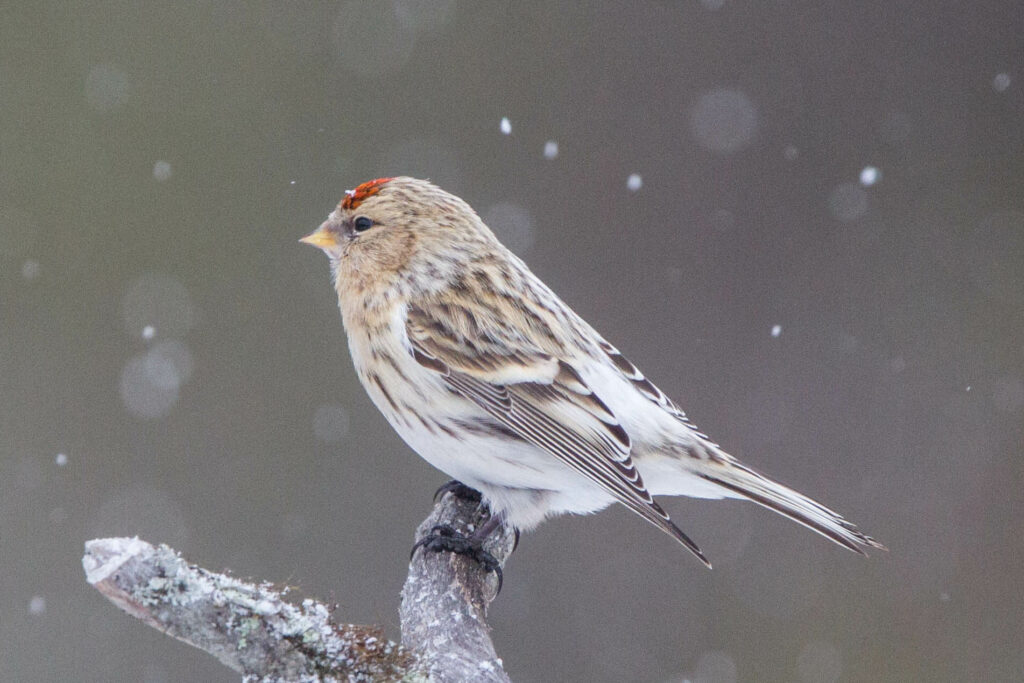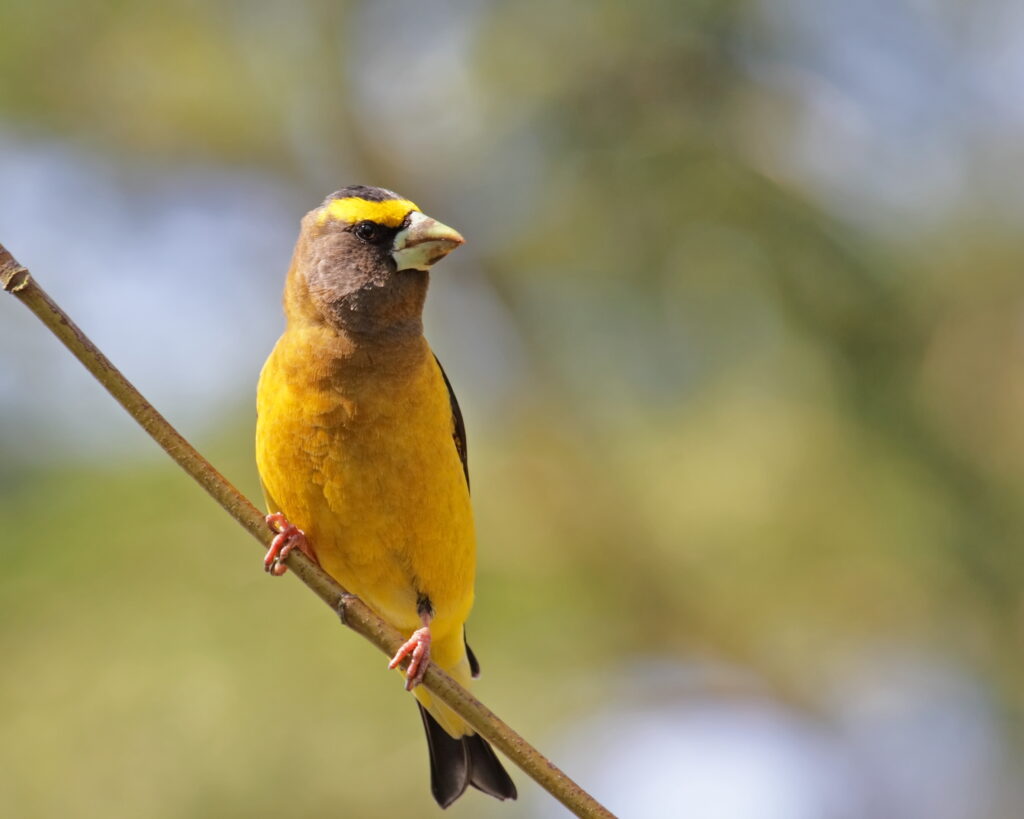Finches are small birds with attractive colors. In America, they can be found in various regions having different species.
The population of American Goldfinch, Purple Finch, House Finch, Common Redpoll, White-winged Crossbill, Pine Siskin, Hoary Redpoll, and Red Crossbill is only one example of the varied and attractive finch species found in Michigan state.
Finches consume mostly seeds; hence they have small, conical bills to make eating easier. Numerous species also consume fruit, buds, and tiny invertebrates.
As a result of the carotenoid pigments gained from their diet, they exhibit substantial sexual dimorphism, with males typically being brighter than females and having plumage that frequently has reddish undertones.
In general, females are drab and have more yellow undertones.
All populations of finch species are consistently found in Michigan, and they are all fairly common. These include House Finches, some of which are not exactly native to Michigan and come from other countries.
There are currently more than 103 different state parks in Michigan, in addition to 5 national parks.
These locations are great for bird watchers, especially in the Eastern Upper Peninsula. In case you want to learn about different species of finches in Michigan, then this guide covers it all in detail.
| Image | Name |
|---|---|
 | American Goldfinch |
 | House Finch |
 | Purple Finch |
 | Common Redpoll |
 | Pine Siskin |
 | Pine Grosbeak |
 | White-Winged Crossbill |
 | Hoary Redpoll |
 | Red Crossbill |
 | Evening Grosbeak |
Types of Finches in Michigan
1. American Goldfinch

The goldfinch is a friendly bird that hunts for food in small groups. This finch normally breeds in July and August and is one of the most frequent birds you will see in Michigan in the winter.
An adult male’s body changes from a summertime black forehead and vivid canary-yellow feathers to a wintertime olive-brown hue.
When they are not mating, they have a social mentality, and males in particular exhibit the most dominance during this time.
It frequents bird feeders, particularly those that have local thistles and milkweeds, enjoys drinking from and bathing in birdbaths, and makes bell-like noises while flying.
In addition to having bright yellow coloring, they also have a black forehead and wings with white patterns and patches above and even beneath their tails.
The mature female, on the other hand, has dull yellowish-green feathers with black wings in the summer and a mixture of olive-brown and somewhat yellowish feathers in the winter.
Their chirping, which resembles the sound “po-ta-to-chip,” is actually a flight call that will let you know they are around.
Habitat
Goldfinches are frequently spotted in open areas, along woodland borders, among low bushes, and even in urban areas.
2. House Finch

The most common songbird in North America and a regular backyard visitor is the house finch. The habitat preferences of house finches are surprisingly adaptive.
Habitat
As suggested by their name, they like to nest and forage for food close to residences, urban parks, farms, shrubby areas, and open forests.
A mature male house finch can be recognized by its combination of brownish underparts and rosy red upper breast. The adult female, in contrast, has simple, grayish-brown feathers with hazy streaks on the bottoms.
It sings loudly in most localities and has a crisp, melodious voice. Although these species don’t migrate, they frequently stray in search of food, including fruits, buds, weed seeds, sunflower seeds, and even insects.
In addition to preferring to eat from birdfeeders on the ground, house finches also frequently rest by perching on tall bushes or trees.
3. Purple Finch

This cute little bird’s name may be deceptive because it is not purple in color. The head, breast, and rear of the males are raspberry-red in hue.
The females have white undersides with dark stripes and dull brown upper parts. Brown wings and a forked brown tail are shared by both sexes. They can be seen year-round in the northernmost reaches of Michigan, which are within their nesting zone.
Habitat
They are forest birds that usually live in mixed-wooded environments and evergreen woods. They build their nests in bushes, on vines, or in the tree forks beneath low-hanging limbs.
The cup-shaped nests are lined with softer materials like roots, grasses, and fur and constructed from twigs and sticks. The greatest time and location to see these finches in the remainder of the state is in the winter at backyard feeders.
They favor affluently forested suburbs. They can also be seen in fields with shrubs and beside waterways. Watch for them in trees or foraging amid shrubs and other ground life.
And keep an ear out for their whining songs. Seeds, berries, and insects are all consumed by purple finches. They prefer millet, nyjer, and sunflower seeds in birdfeeders, particularly the black oil and hulled varieties.
4. Common Redpoll

These finches have white underparts with dark streaks and brownish-gray upperparts. It features a vivid red forehead and a black chin patch. Males’ breasts and flanks may have a reddish tint.
Habitat
The Arctic redpoll is comparable to it, although it is paler. The northern coniferous forests and woodlands are home to common redpolls. However, they can also be found in towns and suburbs.
They construct their nests from grasses, roots, and twigs and line them with soft materials like feathers and hair. Usually, if not directly on the ground, their nests are nearby.
Watch out for their sizable, spirited flocks. Whistling, buzzing, and trilling notes make up the chatty call.
Food
Their diet is largely made up of seeds. However, during the breeding season, they also eat other invertebrates like insects and spiders.
Increase your supply of millet, thistle, nyjer, and sunflower seeds to draw them to your garden feeder. The population of common redpolls is stable overall, and they breed in isolated locations that are largely undisturbed. Climate change could pose a hazard to this species in the future.
5. Pine Siskin

Birds called pine siskins to belong to the finch families of North America. They are renowned for their unpredictable winter migrations and irruptive behavior.
Although they are just slightly shorter than other winter flocks of American Gold Finches at 5 inches, they are rarely missed because they are so proficient at mimicking them.
In order to recognize siskin birds, keep in mind that they are small songbirds with a very pointed, sharp beak and a very characteristic, short-notched tail.
They are as tiny but as animated as they appear to be. The wings and tail of the male siskin are patched, and it has some yellow-green streaking on it.
6. Pine Grosbeak

Little grosbeak finches known as pine grosbeaks are chubby. In males, the head, breast, and back are rose-red; in females, they are yellow.
Habitat
When breeding, they reside in boreal coniferous forests. The cup-shaped nests are lined with lichen, pine needles, and feathers and constructed from twigs, grass, and roots.
Frequently, it is well hidden by thick vegetation next to the trunk. They have a forked black tail, black wings with white wing bars, and black wings.
They can be seen during irruptive winters in regions close to open, evergreen forests, by the sides of the road, or at home feeders where they eat suet, fruit, and sunflower seeds.
The music is a pleasant warble. Pine grosbeaks eat fruit, buds, and seeds as part of their diet. Pine grosbeaks are fairly widespread; however, it seems like their numbers are declining.
7. White-Winged Crossbill

In conifer forests, White-winged crossbills can be seen all year round, particularly when there are huge abundant crops of tamarack or spruce cones.
These species’ adult males are perceived as being rose pink, while their adult females can be perceived as being somewhat green.
Food
They adore eating the seeds from spruce cones. Then, in the summer, they prey on insects, particularly cone and budworms, as well as a few spiders, beetles, and even ants.
They are scarce and frequently seen as bounding in chatter groups traveling between areas of green spruce trees.
They are regarded as gems and treasures of the Northern forests. They are lively tiny songbirds that move in flocks, dig in the snow, and thrive in the cold, which is what makes them so unique.
8. Hoary Redpoll

The hoary redpoll’s light-colored feathers are ideal for concealment against the snow in its Arctic home. Gray-brown on top and white underneath, with darker streaks that are more pronounced in females.
A tiny black chin patch with a red forehead is visible below the bill. In the upper Arctic, brushy tundra areas are where hoary redpolls breed. They build their nests among bushes, tree trunks, rocky outcrops, or stunted trees.
Habitat
They construct cup-shaped nests from twigs, roots, and bark and line them with down, feathers, and soft plant matter. Insects, arachnids, and other invertebrates are also consumed by hoary redpolls, especially in the summer.
This species shares the benefit of isolated, uninhabited nesting grounds with the common redpoll. Although little is known about this elusive species, populations now seem to be stable.
As irruptive migratory, they typically only travel small distances, although occasionally, during the winter, big flocks move much further south than usual.
The best chance to see them in Michigan is now. However, they frequently choose isolated locations. Although it would be rare to have this species in your garden, they occasionally gather in flocks with common redpolls.
They make a variety of vocalizations, including notes that are chatty, buzzy, and rattling and are very similar to those of the common redpoll.
9. Red Crossbill

Red Crossbills are exceptionally unique birds because of their extremely long and pointed wings. They have a remarkable body structure that is nearly entirely covered in deep red and grey feathers.
The body is twisted and crosses over itself. These birds typically form big flocks and remain steadfastly bonded to one another even after the breeding season has ended. These species’ breeding pairs tend to stick together in flocks.
These birds can be found all around Michigan, but during the breeding season, they only go to specific areas in the north and center.
Be aware of these frequent bird gardens, so if you are able to draw them in with your lovely gardens, you are just as fortunate as they are.
Just make sure you’ve used seed feeders and have scattered pine seeds on them. When they come around, they adore this.
10. Evening Grosbeak

A lovely grosbeak finch with a very big, conical bill. The male evening grosbeak has a yellow forehead and a brown back and head. It has yellow underparts and shoulders, a short black tail, and black wings with significant white spots.
The female is olive-tinged on the shoulders and neck and is brownish-gray throughout. In wooded residential and suburban areas, where they frequently use backyard feeders, it is possible to see birds that migrate south for the winter.
The northernmost regions of the state are where you can find evening grosbeaks all year round. They can sound fairly cacophonous in flocks, thanks to their harsh, high-pitched single-note calls.
In wooded areas, orchards, parks, and forests, evening grosbeaks breed. In tall coniferous trees or thick shrubs, they build their nests. The twigs and roots that make up the nests’ saucer form are lined with grasses, pine needles, lichen, and moss.
Food
Feeding on insects and other invertebrates is how the evening grosbeaks live. They also consume fruit, buds, and seeds.
The population of this species has drastically decreased as a result of pest control efforts, disease, the loss of forests, and insufficient food supplies.
Check out this article on Types of Finches.
Conclusion
This guide shares different species of finches in Michigan, which explains their different habitat and living style.
Some can survive in the cold, while others love to nest near the city area.
If you need more details, you can see the FAQ section or visit our site.
FAQ
Are there purple finches in Michigan?
The state of Michigan is covered in purple finches. They are always present in the state’s northern regions, but they only frequently visit the southern regions outside of breeding season.
Use feeders with perches rather than platforms if you wish to encounter one of these finches in your garden.
Last Updated on March 22, 2023 by Lily Aldrin
